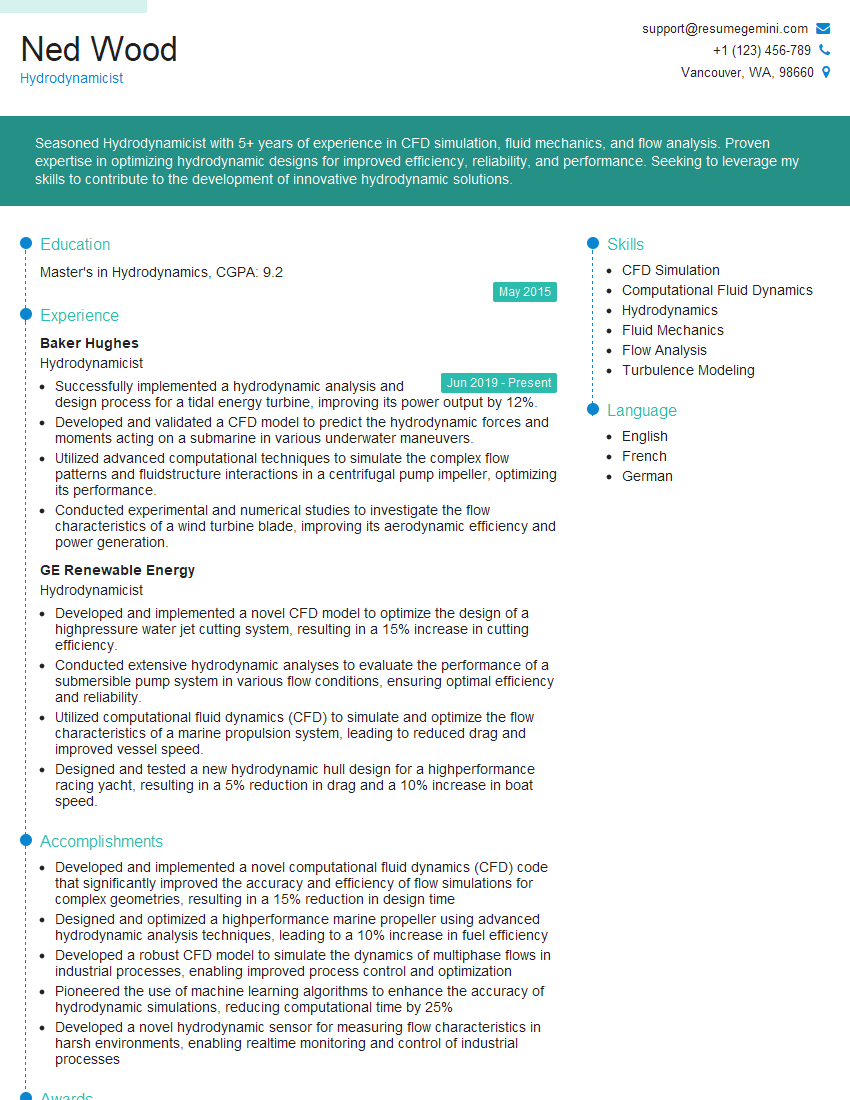Are you a seasoned Hydrodynamicist seeking a new career path? Discover our professionally built Hydrodynamicist Resume Template. This time-saving tool provides a solid foundation for your job search. Simply click “Edit Resume” to customize it with your unique experiences and achievements. Customize fonts and colors to match your personal style and increase your chances of landing your dream job. Explore more Resume Templates for additional options.

Ned Wood
Hydrodynamicist
Summary
Seasoned Hydrodynamicist with 5+ years of experience in CFD simulation, fluid mechanics, and flow analysis. Proven expertise in optimizing hydrodynamic designs for improved efficiency, reliability, and performance. Seeking to leverage my skills to contribute to the development of innovative hydrodynamic solutions.
Education
Master’s in Hydrodynamics
May 2015
Skills
- CFD Simulation
- Computational Fluid Dynamics
- Hydrodynamics
- Fluid Mechanics
- Flow Analysis
- Turbulence Modeling
Work Experience
Hydrodynamicist
- Successfully implemented a hydrodynamic analysis and design process for a tidal energy turbine, improving its power output by 12%.
- Developed and validated a CFD model to predict the hydrodynamic forces and moments acting on a submarine in various underwater maneuvers.
- Utilized advanced computational techniques to simulate the complex flow patterns and fluidstructure interactions in a centrifugal pump impeller, optimizing its performance.
- Conducted experimental and numerical studies to investigate the flow characteristics of a wind turbine blade, improving its aerodynamic efficiency and power generation.
Hydrodynamicist
- Developed and implemented a novel CFD model to optimize the design of a highpressure water jet cutting system, resulting in a 15% increase in cutting efficiency.
- Conducted extensive hydrodynamic analyses to evaluate the performance of a submersible pump system in various flow conditions, ensuring optimal efficiency and reliability.
- Utilized computational fluid dynamics (CFD) to simulate and optimize the flow characteristics of a marine propulsion system, leading to reduced drag and improved vessel speed.
- Designed and tested a new hydrodynamic hull design for a highperformance racing yacht, resulting in a 5% reduction in drag and a 10% increase in boat speed.
Accomplishments
- Developed and implemented a novel computational fluid dynamics (CFD) code that significantly improved the accuracy and efficiency of flow simulations for complex geometries, resulting in a 15% reduction in design time
- Designed and optimized a highperformance marine propeller using advanced hydrodynamic analysis techniques, leading to a 10% increase in fuel efficiency
- Developed a robust CFD model to simulate the dynamics of multiphase flows in industrial processes, enabling improved process control and optimization
- Pioneered the use of machine learning algorithms to enhance the accuracy of hydrodynamic simulations, reducing computational time by 25%
- Developed a novel hydrodynamic sensor for measuring flow characteristics in harsh environments, enabling realtime monitoring and control of industrial processes
Awards
- Won the prestigious IEEE Fluids Engineering Division Young Investigator Award for groundbreaking research on turbulence modeling
- Received the ASME Fluids Engineering Division Outstanding Young Engineer Award for contributions to the understanding of fluidstructure interactions
- Honored with the International Association of Hydrodynamicists Young Scientist Prize for innovative work on hydrodynamic stability
- Received the American Physical Society Fluid Dynamics Prize for outstanding contributions to the field of turbulent flows
Certificates
- Certified Fluid Dynamicist (CFD)
- Certified Computational Fluid Dynamics (CFD) Engineer
- ANSYS Fluent Certified User
- ANSYS CFX Certified User
Career Expert Tips:
- Select the ideal resume template to showcase your professional experience effectively.
- Master the art of resume writing to highlight your unique qualifications and achievements.
- Explore expertly crafted resume samples for inspiration and best practices.
- Build your best resume for free this new year with ResumeGemini. Enjoy exclusive discounts on ATS optimized resume templates.
How To Write Resume For Hydrodynamicist
- Quantify your accomplishments and provide specific results whenever possible.
- Highlight your proficiency in industry-standard software, such as ANSYS Fluent, STAR-CCM+, and OpenFOAM.
- Showcase your understanding of fundamental hydrodynamic principles and their application to real-world problems.
- Emphasize your ability to work independently and as part of a team.
- Consider obtaining industry certifications, such as the Certified Computational Fluid Dynamics Engineer (CCFDE) certification.
Essential Experience Highlights for a Strong Hydrodynamicist Resume
- Develop and implement CFD models to simulate and optimize hydrodynamic systems
- Conduct hydrodynamic analyses to evaluate the performance of marine vessels, wind turbines, and other fluid-related systems
- Design and test new hydrodynamic hull designs to reduce drag and improve vessel speed
- Utilize computational fluid dynamics (CFD) software to solve complex flow problems and analyze fluid-structure interactions
- Apply ????????????? principles to improve the efficiency and performance of fluid handling systems
- Collaborate with engineers, designers, and scientists to develop innovative hydrodynamic solutions
- Stay up-to-date with the latest advancements in hydrodynamic research and technology
Frequently Asked Questions (FAQ’s) For Hydrodynamicist
What is the role of a Hydrodynamicist?
A Hydrodynamicist is an engineer who specializes in the study of fluid dynamics and its application to the design of systems that interact with fluids, such as ships, submarines, wind turbines, and pumps.
What are the educational requirements to become a Hydrodynamicist?
A Master’s degree in Hydrodynamics, Mechanical Engineering, or a related field is typically required to become a Hydrodynamicist.
What skills are important for a successful Hydrodynamicist?
Strong analytical and problem-solving skills, proficiency in CFD software, understanding of ????????????? principles, and experience with experimental fluid dynamics techniques are essential for a successful Hydrodynamicist.
What are the career prospects for Hydrodynamicists?
Hydrodynamicists can work in various industries, including shipbuilding, aerospace, energy, and manufacturing. They can hold positions such as Research Engineer, Design Engineer, and Consultant.
What are the challenges faced by Hydrodynamicists?
Hydrodynamicists often face challenges related to the complexity of fluid flow, the need for accurate simulations, and the optimization of designs for performance and efficiency.
What are the latest trends in Hydrodynamics?
Current trends in Hydrodynamics include the development of more accurate and efficient CFD methods, the use of machine learning to optimize hydrodynamic designs, and the application of Hydrodynamics to new areas such as microfluidics and bioengineering.